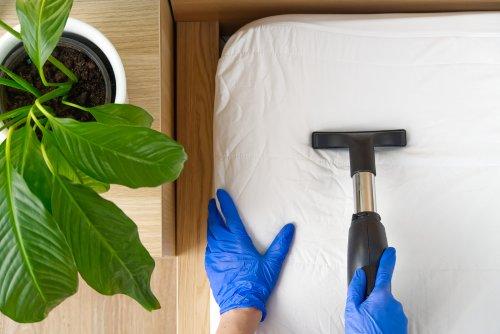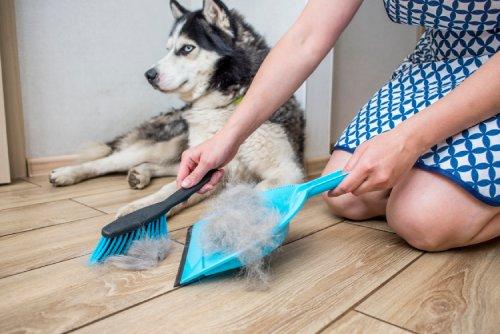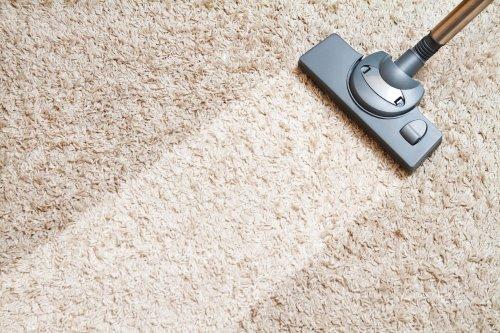Home / Blog / A Complete Guide to House Cleaning for Allergy Sufferers
A Complete Guide to House Cleaning for Allergy Sufferers

Scientifically reviewed by Daniel Baldwin, BCE, CCFS, CP-FS
-Published on August 16, 2022
-Updated on September 19, 2023
If you suffer from hay fever, dust allergy, or asthma, you know the outdoors are fraught with allergy triggers. But are our homes any better? With close to 60 million Americans experiencing environmental allergies for a few months or year-round, this is a question that interests many of us.
While you can’t do much to influence the external environment, you have the power to control the closed space in your home. When it comes to housecleaning for allergies, there are best practices you can follow to relieve your suffering indoors. If you are ready to turn your home into an easy-to-breathe space filled with clean air, read on for our cleaning tips for allergy relief.
What makes allergies worse indoors?
Allergic rhinitis is the medical term for hay fever and seasonal allergies. In our homes, it is triggered by various irritants. The main culprits are pollen, animal dander, house dust mites, cockroaches, or mold spores. These small particles are hard to deal with, but there is good news. With some effort and a regular cleaning schedule, you can significantly reduce allergens in your adobe and improve your days (and nights).
Evict allergy triggers from your home
According to the American College of Allergy, Asthma & Immunology, reducing or eliminating your exposure to the allergen triggers is the first course of action for hay fever. Let’s look at the main ways you can do this.
Choose hypoallergenic bedding
Our bedding easily collects dust mites and pet and human dander. Make sure you are using washable ones and that you change them weekly. Wool and feather bedding is not recommended, with modern hypoallergenic synthetic materials better suited for people with allergies. You could also explore special dust-mite-proof bedding for your mattress and pillows.
Install the right blinds
Drapes and curtains are incredible dust collectors. If you really like them, shop for washable ones in cotton or synthetic fabrics, and ensure they don’t touch the ground. A better alternative is to switch to roller-style shades. Likewise, horizontal blinds should be avoided as they attract dust.
Consider your flooring
Rugs and carpets are just as bad when it comes to trapping allergens. They are also hard to clean thoroughly. In comparison, hardwood, tile, or vinyl floors are a breeze to sanitize, and they attract fewer allergens in the first place. Small rugs that you can regularly clean in the washing machine are the middle ground if you like to add some floor decor to your home.
Dry bathroom towels and mats
The no-rug and carpet policy doesn’t have to apply to the bathroom. Small, washable decor rugs are perfectly fine, and so are shower mats. What’s important is to always dry them (and your towels) after each use to help the room dry completely and prevent mold growth. For this reason, you should always run the fan during and after your shower.
Pick easy-to-clean furnishing
Upholstered furniture is harder to maintain, even using stain removal products. Choose furniture you can easily clean, like wood, leather, metal, or plastic. Line the top of your cabinets with wax paper to trap allergens and make deep cleaning your home effortless.
De-clutter
Keep your home as clutter-free as possible. Busy displays and open bookshelves might add personality to the room, but they are hard to clean and often harbor dust and other allergens. To reduce indoor allergens, limit decorative items and put them behind glass. Store knickknacks, toys, mementos, and bits and pieces in hard-sided, sealed containers. Avoid cardboard boxes since they can absorb humidity, which can lead to mold and mildew, and are potential food and nesting spots for pests.
Set rules for your pets
We love our pets, they are part of the family, but when they cause incessant sneezing, runny noses, and watery eyes, you need to set some ground rules. Never let your pets in the bedroom, and make the couch off-limit. Brushing them outside daily and washing them every week helps control the amount of pet dander shed inside and improves the quality of life of pet owners with allergies.
Take care of your clothes
The last thing you need is to wear clothes covered in allergens. Keep dust away from clothing by closing your wardrobe doors and having dedicated space for your half-used clothes — don’t just leave them on the floor or a chair. Storing out-of-season clothes or special items you don’t regularly wear in a plastic bin or vacuum bag will keep them clean and ready to use.
For the same reason, you should also stay away from line-drying your washing as you’ll be exposing your clothing to pollen, dust, and other airborne allergens — use a dryer, or indoor clothes rack instead.
Wash your hair and body
Lastly, you shouldn’t forget about yourself. Showering or taking a bath before bed is a relaxing ritual that will wash away pollen from your hair and skin. Take care to dry completely before going to sleep, or you could make your bedding damp and at risk of developing mildew.
Continuous cleaning is key
Now that we know where many allergy triggers are in our homes let’s look at some of the best house cleaning tips for allergy sufferers.
Make cleaning safe
The process of cleaning your home can be a problem for allergy sufferers. There are a few things you can do to limit your exposure.
Choose the right products
Be careful with your selection of cleaning and laundry products. Heavily scented cleaners permeate the room for a long time and can cause allergy-like symptoms during and after cleaning. Use fragrance-free products instead. You should also avoid aerosol products and chlorine bleach.
When buying your cleaning product, keep an eye out for chemicals that are known irritants, such as formaldehyde, ammonia, and sodium lauryl sulfate (SLS). If the bottle doesn’t have an ingredients list, don’t buy it. Nowadays, there are a number of natural cleaners available in shops, and, if you have the time, you can make your own DIY cleaners. From laundry detergent to glass cleaners, you can easily whip up a homemade product that is better for your allergies and your wallet.
Select the best cleaning tools
Traditional cleaning methods like dusting and sweeping stir up dust. Instead, use cleaning tools that trap and remove dust. Damp microfibers cloths and mops collect dust and allergenic particles as you work and are quick to wash and clean once you are done. As cleaning equipment choices go, you should also avoid bagless vacuum cleaners as they release a lot of airborne irritants when emptying and cleaning the dirt cup.
Wear a mask
Even if you have done a top-notch job selecting the right cleaning products and tools, there are still plenty of allergens ready to trigger your symptoms when you clean. Wearing a mask while doing household chores is a great way to protect your airways. You could even consider safety goggles if your eyes get irritated during cleaning. When you are done, go for a walk outside to literally let the dust settle.
Eliminate pests
Pests can make your allergies worse and hinder your efforts for a clean home. From cockroaches to rodents, these critters are not just unsightly but a real health concern. If you find yourself losing the fight, get professional pest control technicians in to resolve the issue once and for all.
Establish a home cleaning schedule
With all the preparation out of the way, it’s time to clean your home. Sticking to a regular cleaning routine is the best way to ensure all the chores get consistently done and that you reduce allergens in your home. This is our recommended cleaning schedule:
- Bed: wash or change sheets and pillowcases weekly, comforters and duvet monthly, pillows every three months, mattress twice a year.
- Curtains: wash every three months.
- Bathroom mats: dry after every use, change weekly.
- Bathroom surfaces: tidy and wipe daily, clean weekly.
- Vacuum: daily for high-traffic areas and weekly for the entire house.
- Ceilings, fans, light fixtures, and walls: clean monthly.
- Baseboards: dust every other week.
- Gaskets (in the fridge, dishwasher, garbage disposal, etc.): clean monthly.
- Outside entryways: clean floors and walls monthly.
- Kids’ toys: wash twice a year.
Improve your housecleaning and breathe easy
Armed with this new knowledge, you are ready to get the job done. Adopt as many of our house cleaning tips for allergy suffers as possible and act today to transform your home into an oasis where you can breathe freely.
Related Articles
Visit our blog to learn more.
→








